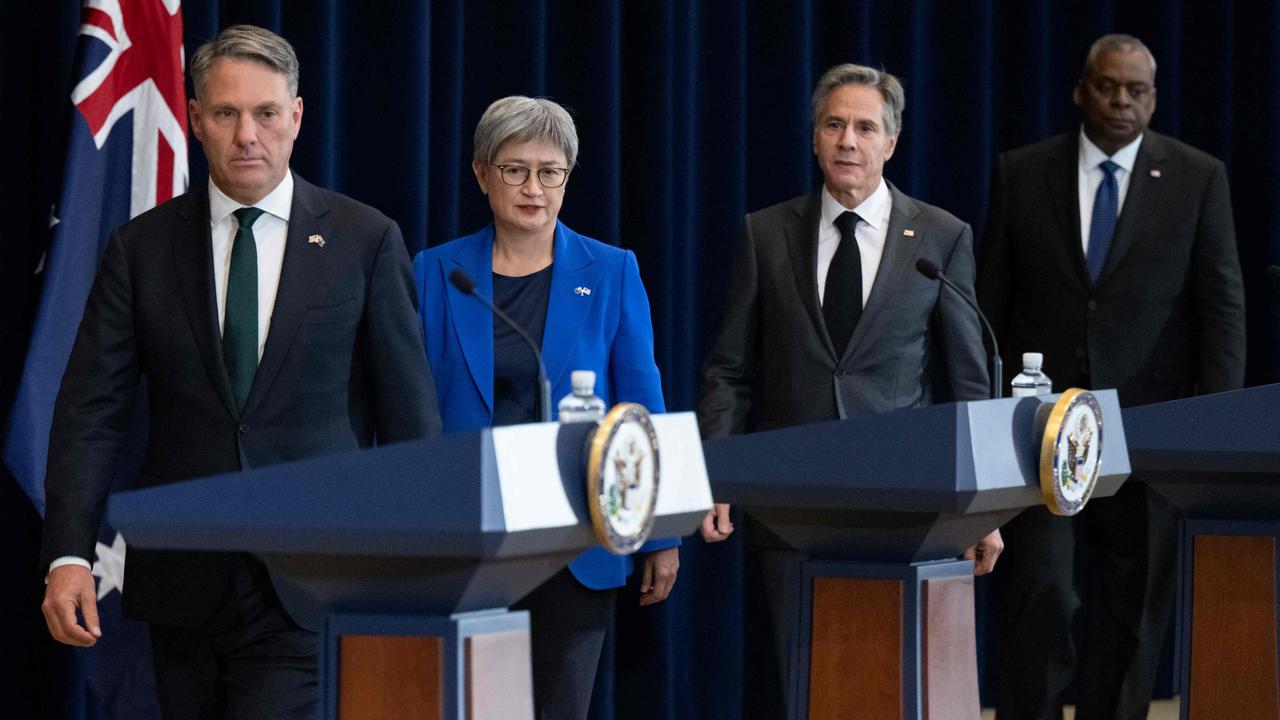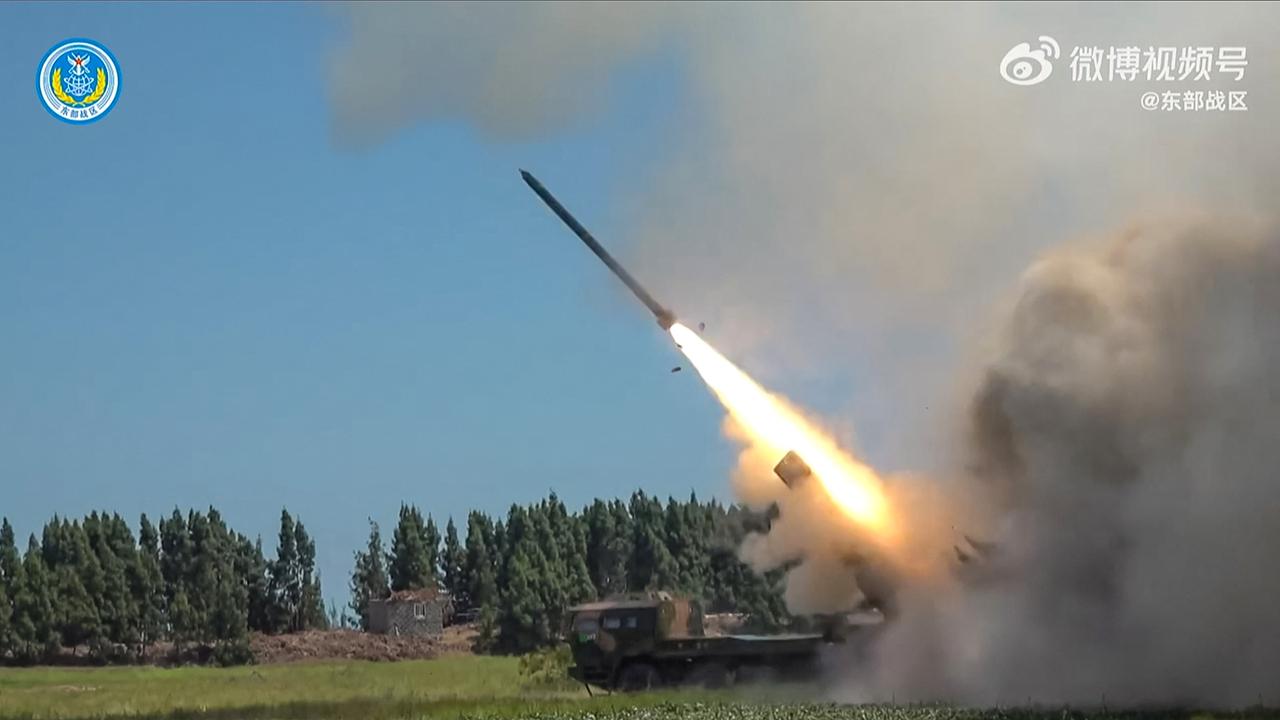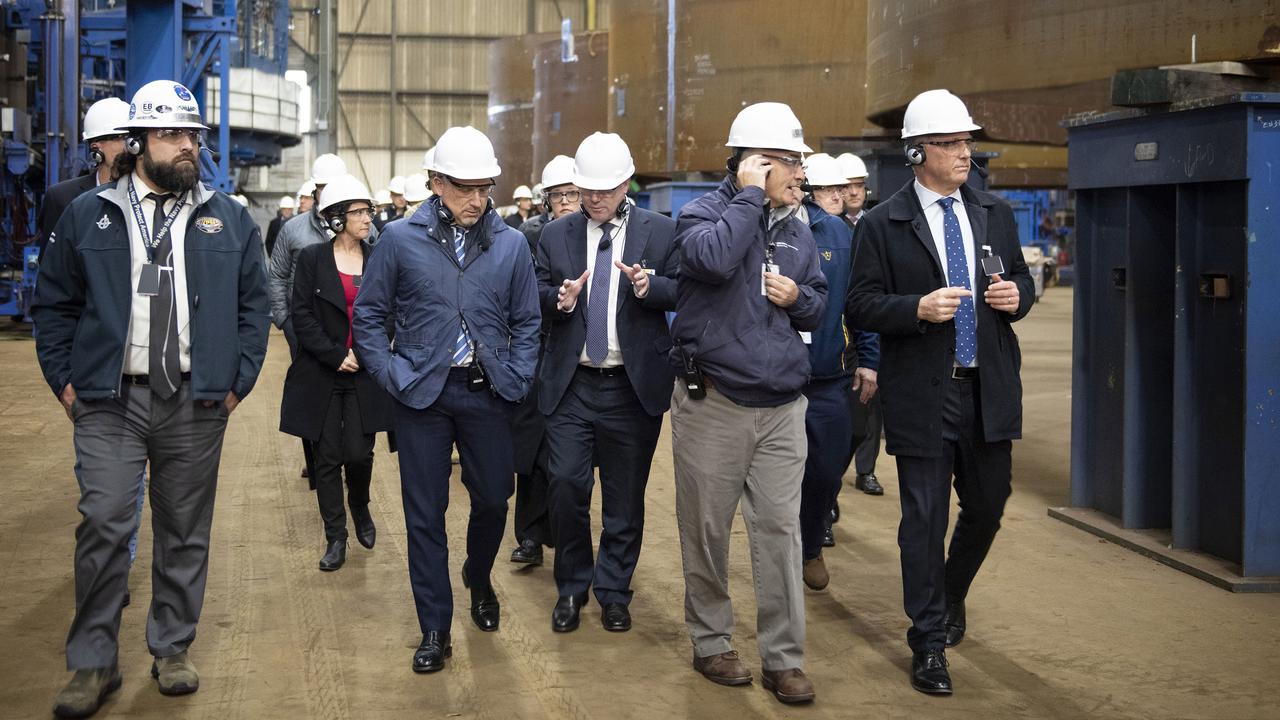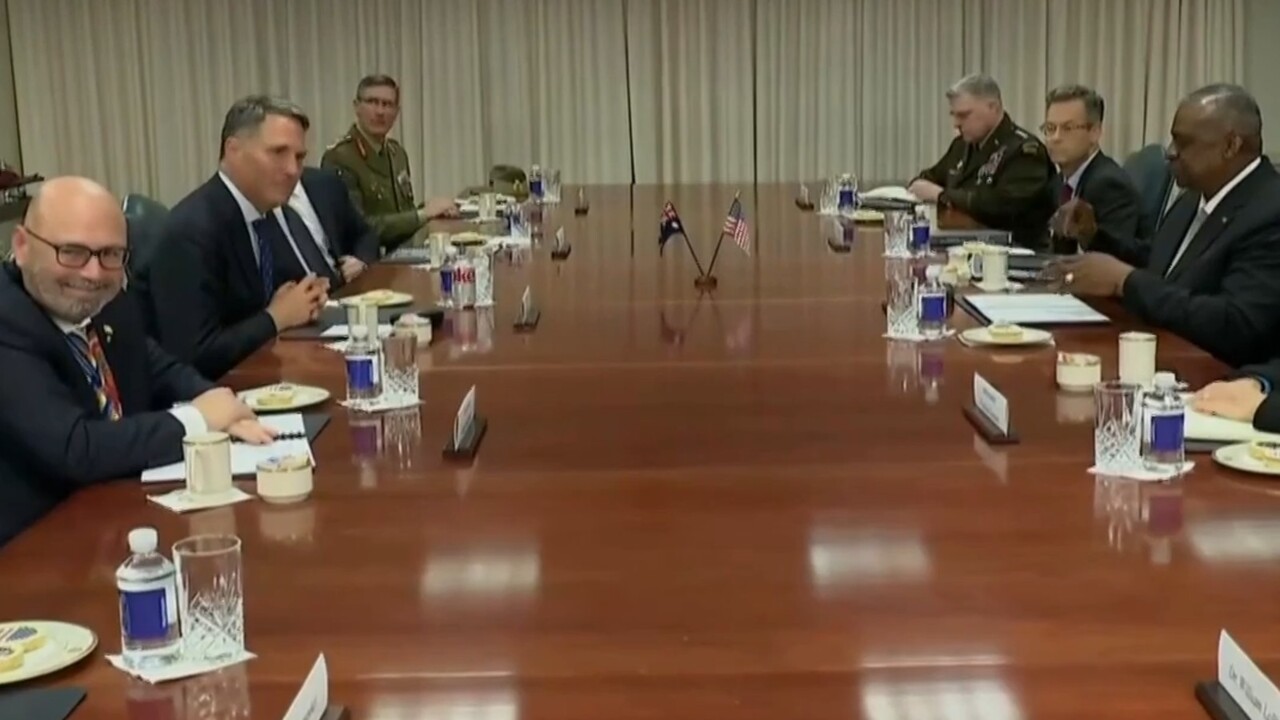The Chinese military is everywhere, not least at the AUSMIN meeting just held in Washington.
AUSMIN brings together foreign and defence ministers from the US and Australia and is the chief vehicle for managing the alliance. The latest AUSMIN meeting produced this remarkable declaration by US Defence Secretary Lloyd Austin: “We recognise where Australia is and when its capability begins to diminish. And, of course, we will address all of that in that pathway that we create. So we will not allow Australia to have a capability gap going forward.”
Defence Minister Richard Marles responded: “We really appreciate those comments.”
Austin meant a submarine capability gap, as our antique Collins-class subs enter their dotage and begin their final, late retirement in the late-2030s, long before we acquire our fleet of eight nuclear-propelled submarines under the AUKUS pact.
The only nation that Australian submarines could possibly be relevant to, adversarially, is China. The world is rightly transfixed by Russia’s monstrous aggression in Ukraine, but there is only one peer competitor for the US – China.
Everything consequential in regional diplomacy – AUKUS, the Quad, enhanced US/Australia military interaction with the integration of Japan into the US/Australia alliance – is all about China’s burgeoning military.
The recent Pentagon report on the People’s Liberation Army, as Beijing’s military is known, explains why.
At the AUSMIN press conference, Austin outlined increased US military involvement with Australia: “We agreed to deepen our defence co-operation … we will increase rotational presence of US forces in Australia. That includes rotations of bomber task forces, fighters, and future rotations of US Navy and US Army capabilities. We will expand our logistics and sustainment co-operation. We will find ways to integrate our defence industrial bases … We agreed to invite Japan to integrate into our force posture initiatives in Australia.”
The US can cover any Australian submarine gap simply by having its nuclear submarines patrol here more often. For the moment, home-porting US subs in Australia has been ruled out. Whatever the political considerations, Australia, at the moment, has neither the physical facilities nor the legislative framework to cope with such an arrangement. But it could come back on the agenda.
More Australian sailors
will get experience on US nuclear boats. The most obvious way to bridge the capability gap is for Australia to lease or buy one or two US Virginia-class nuclear subs. After a subsequent AUKUS defence ministers’ meeting, Marles made clear the Brits would get some of the action, that is to say lots of money, out of the Australian AUKUS subs. This could happen many ways – they may help us with the ultimate Adelaide build, for example. Even stop-gap leased Virginias would be a long time off.
The bottom line is unless we finance a new US production line to build our first Virginias, before later building the ultimate AUKUS sub in Adelaide, we are not adding anything to allied military strength.
Austin and US Secretary of State Antony Blinken condemned China by name for its military aggression. Austin: “China’s dangerous and coercive actions throughout the Indo-Pacific, including around Taiwan, toward the Pacific Island countries, and in the East and South China Seas, threaten regional peace and stability.”
Marles and Foreign Minister Penny Wong warmly endorsed Austin’s and Blinken’s remarks without specifically naming China. However, they were clear and forthcoming on overall intent. Wong did say Australia highly values its informal relationship with Taiwan.
In a later, impressive speech to the Carnegie Endowment she was explicit about the threat Beijing’s behaviour poses and the need for it to co-operate with the Biden administration in managing strategic competition. She forthrightly declared: “Australia sees enhanced defence capabilities as essential for deterring conflict in our region.”
Albanese, Marles and Wong, in everything they say and do, exhibit strategic realism and close alignment with the US. Marles and Wong both reiterated the key judgment that these are the most perilous strategic times since World War II.
There is only one reason for this: Beijing’s frenzied military development and sustained outlook of aggression.
China officially spends about $US230bn ($342bn) on its military. Soldiers are cheaper in China so it gets a lot for its money. It also conceals vast amounts of defence spending. Jane’s military journal thinks another $US60bn.
Because Beijing pursues a military/civilian fusion defence strategy, it is uniquely able to harness vast parts of its economy, development strategy and intellectual property theft to support its military capabilities.
The most systematic account of the Chinese military comes in the recently released Pentagon report on China’s military and security developments. It states that one purpose of Beijing’s build-up is “to restrict the US from having a presence in China’s immediate periphery and limit US access in the broader Indo-Pacific region”.
Beijing, says the Pentagon, plans by 2049 to “match or surpass US global influence and power, displace US alliances and security partnerships in the Indo-Pacific region, and revise the international system to be more advantageous to Beijing’s authoritarian system”.
The analytical elements of the Pentagon report are less powerful than the straightforward description. The PLA has a total force of about two million service personnel. Its official policy is to be able to “fight and win” wars against “a strong competitor”, which is code for the US. It possesses the largest navy in the world, with approximately 355 ships and submarines, including some 145 major surface combatant ships.
It has 2800 military aircraft, including 2250 combat aircraft. It has a separate land-based “Rocket Force” which commands intercontinental ballistic missiles, medium-range missiles, and hypersonic missiles. Its army has nearly a million soldiers.
It is pushing the development of new nuclear weapons at break neck speed, in great contrast to the Biden administration, which until recently has been trying to de-emphasise the role of nuclear weapons. The Pentagon says China has accelerated the production of nuclear weapons, beyond even what the Pentagon itself estimated as recently as 2020. The Pentagon expects China to have “700 deliverable nuclear warheads by 2030”, and 1000 warheads by 2027.
Beijing supports nuclear weapons production by building fast breeder nuclear reactors and reprocessing facilities. Beijing has so many reactors under production that by the end of the decade it will have produced so much plutonium that it could well develop many more than 1000 nuclear warheads. It is developing multiple independently targeted re-entry vehicle capabilities for its nukes, which makes them much less susceptible to any missile defence.
It has developed an air-launched ballistic missile, so that it now has a nuclear triad. It can launch strategic nuclear weapons from land, from submarines and from the air. The Pentagon says China has moved from “minimum deterrence” to a “launch on warning” posture, which the Pentagon defines as “where warning of a missile strike leads to a counterstrike before an enemy first strike can detonate”.
China has thousands of missiles. In 2020, it launched 200 ballistic missiles for testing and training, more than the rest of the world put together.
The Pentagon says Beijing is working assiduously to develop “counter-space” capabilities, the ability to destroy an adversary’s communications satellites. The Pentagon says Beijing deploys “dual use” technology in space. Dual use technologies have an obvious civilian use but, without significant modification, can be turned to military purposes.
The Pentagon says Beijing engages in “biological activities with potential dual-use applications”. The Pentagon has similar concerns over chemical weapons.
The Pentagon claims China makes massive efforts, beyond its formal military budget, to contribute to its military effectiveness. It runs huge influence operations. Part of this is internet-based and increasingly mobilises artificial intelligence. But much of it is old-fashioned influence peddling, mostly with money.
It massively invests in cyber capabilities and uses both cyber and traditional espionage to gain militarily valuable intellectual property.
Marles has said, correctly, that this is the greatest military build-up in peace time. It’s rare in history for a military build-up on anything like this scale not to result in the military being used. If you spend all your effort and treasure building a hammer, you will eventually find a nail.
Beijing’s massive military expansion, combined with its newly aggressive outlook, is acutely destabilising, nothing more so than its nuclear weapons expansion. It refuses to participate in US/Russia arms control agreements. All through the Cold War, the US managed an acutely sensitive bilateral nuclear arms balance with Moscow. Managing a three-way nuclear arms system of Mutually Assured Destruction will be much more challenging and dangerous.
So what is Beijing doing all this for? Malcolm Davis, a respected military analyst at the Australian Strategic Policy Institute and a student of the Chinese military, has no doubt: “The Chinese are conducting their military build-up for a purpose. They’re not doing it for fun. They’re planning to go to war over Taiwan. In a decade we’ll be at war with China over Taiwan. We should be preparing for it and we’re not.”
In some ways it’s unfair to Davis to present his conclusion in such a bald fashion, without citing the years of work and analysis he has put into this question. In any event, he is only stating bluntly what countless strategic leaders – including Americans at the highest level – say, often in private, sometimes in public.
Mike Green, the chief executive of the US Studies Centre at Sydney University and a former Asia Director at the US National Security Council, puts it slightly differently: “China is developing the capability to fight and win wars, including in Taiwan.”
Green’s point is that China wants the capability to be able to do that, but it hasn’t necessarily made the decision that it will do that. Green thinks that while the US cannot be sure it could defeat China over Taiwan, China also cannot be sure it could defeat the US. And the cost would be horrendous. Therefore, deterrence will probably prevail.
Former prime minister Scott Morrison made a similar point when he told the Hudson Institute that full-scale conflict would be suicidal for China, that the Chinese economy would be devastated, hurt much worse than the US economy.
Green and Davis agree that China’s military build-up is the greatest we’ve seen in peace time. Says Green: “Beginning in the 1990s, the PLA’s budget increased by double digits every year for 25 years. In the mid-1990s the Chinese effort began. Its purpose was to deny the US an easy victory in Taiwan. But from about 2009 it changed from denial to control, especially in the first island chain, but even in the second island chain.”
Sea denial is where a power can prevent an adversary from operating safely in a maritime area. Sea control is when a power can effectively operate in that area no matter what an adversary does.
Green offers a disturbing historical parallel, nonetheless. In the years before World War I, German policy was subservient to the Schlieffen Plan. This was named after Field Marshall Alfred von Schlieffen and held that for Germany to prevail in a European war it had to invade France not directly but through Belgium and the Netherlands.
The German government was constantly told by its diplomats that any action like this would bring Britain into a war, which would be disastrous. German policy was not for war, but diplomacy and national action were subordinate to facilitating the Schlieffen Plan, just in case.
Similarly today, Beijing’s actions are all dictated by military policy. It has no diplomatic or economic need of artificial islands in the South China Sea. Their only purpose is military. Similarly, it has no serious economic interest in the South Pacific. Its national interest there is to acquire a military base, not least so that Australian forces would be tied down locally in the event of conflict and unable to move north to assist the Americans.
“It’s always concerning when you see diplomacy subordinate to military policy,” Green tells Inquirer.
Right now, today, there are countless actions Beijing could take against Australia. At the extreme end it could fire ballistic missiles at us, without nuclear warheads, from mainland China. More realistically, it could hit our bases in northern Australia with its DF-26 medium-range missiles. As the Pentagon says, it can also conduct long-range precision strikes from weapons based on ships, submarines and planes, any of which it could easily move into range of the Australian mainland.
These are extreme kinetic measures which would only happen in war. But it could also close the South China Sea to our trade. Or possibly cripple our civilian infrastructure through intense cyber attack. If it gets bases in the South Pacific, it might confront us any day in our own waters. Even now, it sometimes harasses our ships and planes, as it does very often to Japanese and Taiwanese ships and planes, and sometimes to Southeast Asians and even to the Americans.
As a middle power, there’s a limit to what we can do. But if we had thousands of medium-range missiles of our own, we could keep adversaries at a distance, or at least pose real risks to them. At the moment, we can do none of that. We lack, in Marles’s slightly clunky term, “impactful projection”.
Prudent military policy should plan against capacity more than intent. If AUSMIN, AUKUS, the Quad, the Trilateral Security Dialogue with the US and Japan, the Five Eyes – and all the other acronyms we are part of – help us to acquire decisive capability and deterrence, then they are a very good thing.
If not, we may one day discover that you can’t defeat missiles with acronyms.





No comments:
Post a Comment